Corporate brands that work for profit unabashedly generate awareness about their offering by reaching out to a wide audience.
So, why shouldn’t non-profit organizations?
Given that your nonprofit operates for the greater good, it’s just as critical you build connections for procuring funds. But only when potential benefactors learn about the change your organization wants to bring can they contribute to keeping your cause alive.
That way, one of the most effective methods for nonprofits to spread the word of their deeds is through email newsletters. These letters are an inexpensive way to inform your potential supporters of the latest updates and request contributions and volunteer work to further bring social change.
Why Does Your Nonprofit Outfit Need Email Newsletters?
- For starters, nonprofit email newsletters allow in-depth personalization. They offer one-on-one time with the reader, where nonprofits can narrate their cause and how it might resonate with the potential contributor.
- Also, contributions don’t only come in the form of monetary aid. Through newsletters, NGOs can inform and invite volunteers and prospective supporters to join their cause.
- If you have a well-crafted newsletter sequence, complete with design and content, you can continuously update and share relevant information with your supporters. Using a newsletter sequence and template will reduce your email campaign turn-around time.
- Sending timely newsletters with consistent branding and content also makes you look more genuine and credible in the eyes of your potential benefactor. Like it or not, appearances matter, especially when you’re requesting cold leads to donate in any way.
- Lastly, research shows that most people who support charities prefer to receive communication from nonprofits over email.
So, it’s safe to say that crafting a poignant newsletter can mean the difference between people reaching out with alms versus turning a blind eye to your cause. If you’re wondering how to write a hard-hitting series of newsletters, read our next section to see how experts do it.
Examples of Good Nonprofit Newsletters That Will Move You
Here are 7 Nonprofit email newsletters to inspire you:
1. Volunteer Newsletter
Let’s face it! It’s never easy to convince people to work for you for free – even if it is for a good cause. Such is the case not because individuals dwell without empathy but simply because they are busy. However, if your appeal for help moves them, they will sit up and take notice. You must keep this in mind while designing your volunteer newsletter.
Here are a few tips that can help you create impactful newsletters inviting volunteers:
- Write a compelling copy, and let people know why you’re looking for help right from the get-go. However, do provide them with a rationale or a story of how previous volunteer efforts have helped those in need.
- Don’t forget to add visuals if you can.
- Create strong CTAs to encourage the reader to take action.
Check out this volunteer newsletter by the Red Cross. This newsletter rakes in a potential volunteer’s attention with its compelling copy and encourages them to take action. Also, it features a singular dedicated CTA, which doesn’t distract the reader from the main task at hand, which is to schedule an appointment to donate blood.
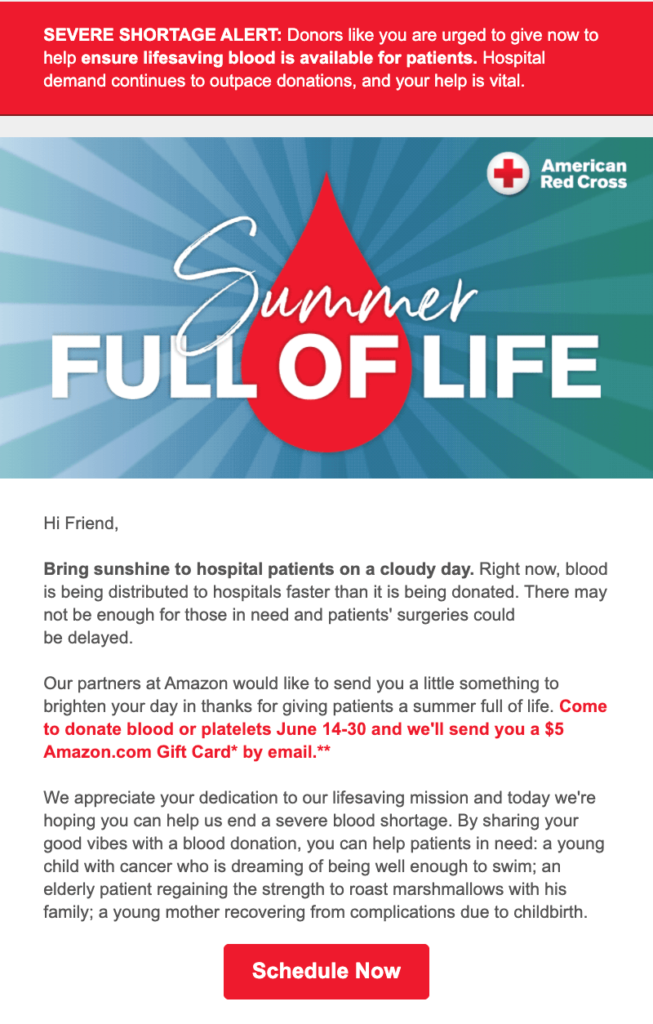
2. Fundraising Newsletters
Financial contribution keeps your cause alive, and asking for it requires a genuinely moving email newsletter that’s hard to turn away from. Here are a few tips for writing an impactful fundraising newsletter.
- Firstly, ensure you’re sending newsletters to an appended email list. This pointer is common for any newsletter you send. Remember that emails sent to an abandoned inbox will severely hamper support.
- Use compelling imagery, headline, and body text that evokes empathy.
- Your CTAs must directly link to a payment portal or gateway.
Refer to this fundraising newsletter by Help for Heroes. This nonprofit sells merchandise, the proceeds of which go in rehabilitating veterans. Here, they use a moving image supported by a concise copy. Also, look at the powerful CTAs, which inform the reader of the next action they must take.

3. Donor Newsletters
The primary purpose of this newsletter is to keep contributors informed on the social change their donation is already bringing. Doing this encourages donors to continue providing financial support to your nonprofit organization.
Here are a few tips to keep in mind while drafting this newsletter:
- Do not add stock images when drafting a donor newsletter. Instead, use field pictures or videos to show the change a donor’s contribution brought along.
- Since contributors like reading about the good they were responsible for, you can use a lot more text here as opposed to newsletters sent to cold leads.
Here is a donor newsletter by the American Red Cross that offers a report with a real-life video informing the reader of the lives their donations uplifted.
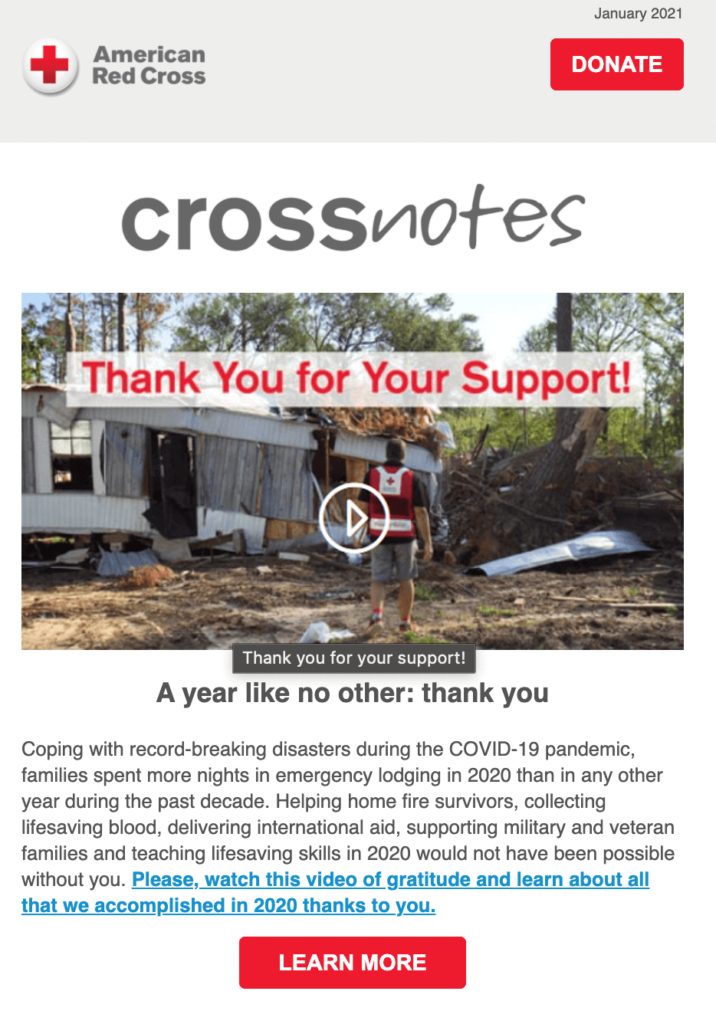
4. Charity Newsletters
You can draft a charity newsletter to inform donors, potential contributors, and volunteers about the work your charity does. It can also contain updates on the latest developments and successes your mission achieved.
Here are a few tips for writing these newsletters well:
- Use field images to highlight a donor’s impact.
- Provide a CTA to donate more.
- Since these newsletters also announce a charity to potential new donors, the text can contain a couple of the cause’s success stories.
Look at the newsletter of UNICEF Australia. It kicks off its newsletter with a great headline, celebrates its volunteers through striking imagery, and provides a CTA to attract donations.
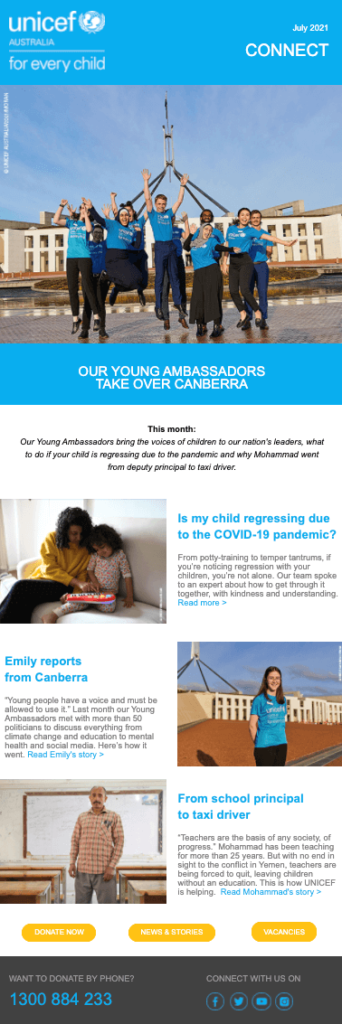
5. Association Newsletters
This newsletter highlights the achievement of a charity association over a longer duration of time, say a year. You can announce the change your association brought in a specific geography or a report that you published to spread awareness.
Here is LSE’s Institute of Global Affairs’ newsletter announcing a report on several social issues, including gender equality, environment, etc. Check how it uses a full-page image with minimal text and impactful headlines to instantly capture the reader. It also has a single CTA, which prompts the reader to view the report.
Why did we emphasize the “single CTA” part?
Because research suggests that emails with a singular CTA can increase your click-through rate by a whopping 371%.

6. Nonprofit Holiday Newsletter
Holidays and festivals offer an excellent opportunity to reconnect with both new and old customers through a newsletter. Draft one that reflects what your nonprofit does alongside wishing readers happy holidays.
Here are a few tips for drafting one:
- Keep text minimal and add more images and videos.
- Provide a link to your website where they can donate, but don’t include a direct “donate” CTA.
The National Foundation for Ectodermal Dysplasias does it especially well. Check out their holiday newsletter with a video of a child who suffers from the condition.
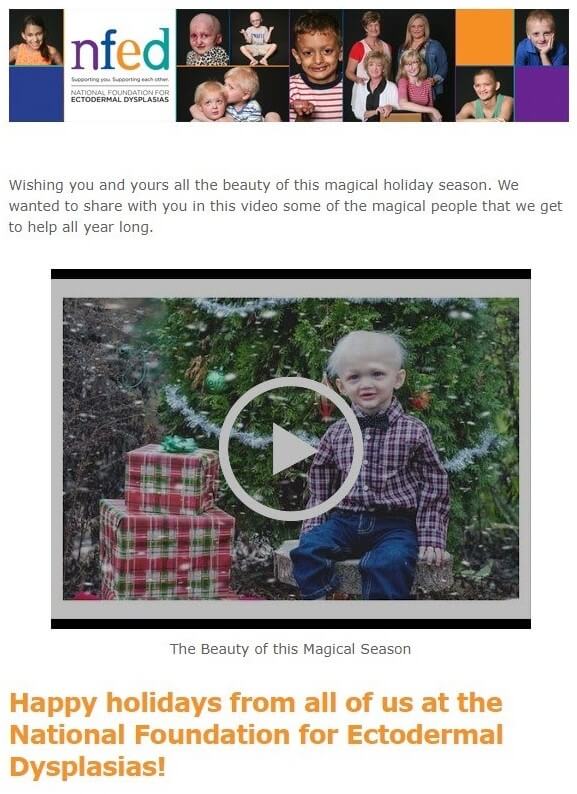
Also read: 10+ Best Holiday Newsletter Ideas
7. End of Year Nonprofit Newsletter
An end-of-year newsletter can mean more donations for your nonprofit. Here are a few nifty tricks to draft these newsletters.
- Create a sense of urgency – frame it as a last good deed before the year is up.
- Use catchy headlines.
- Add striking imagery with a powerful CTA.
The Example by the International Rescue Committee combines all these tips to create an engaging end-of-year newsletter, as you can see. In addition to creating a compelling case for donation, they also provide a percentage breakup of where a donor’s funds go towards the bottom of the newsletter. This further builds a cause’s credibility.
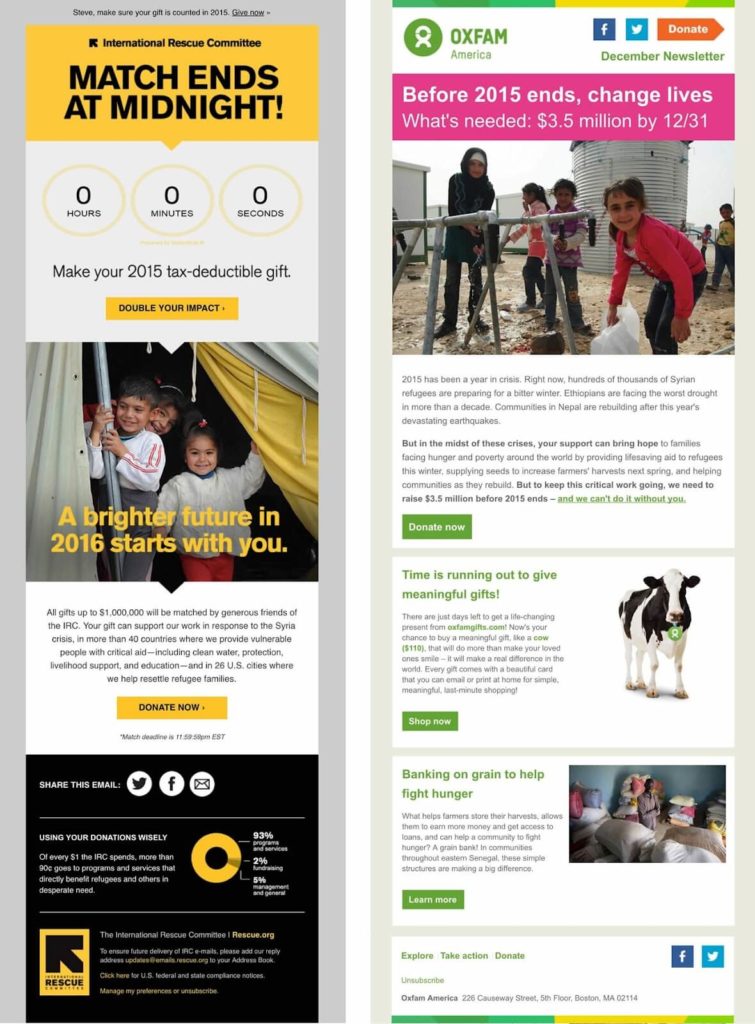
Source: npENGAGE
Take The Best Nonprofit Newsletter Template
We’re sure these 7 examples, along with the tips to write nonprofit newsletters, will help you make your’s open-worthy for your readers. So, make sure you lay enough emphasis on clarity, design, CTA placement, images, and video distribution.
Once you have all these elements under control, take some time to hammer out a strong subject line for all categories of newsletters mentioned above. After which, rest assured you’ll touch your reader’s hearts and encourage them to be one with your cause.
Also read:

